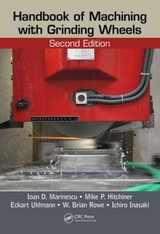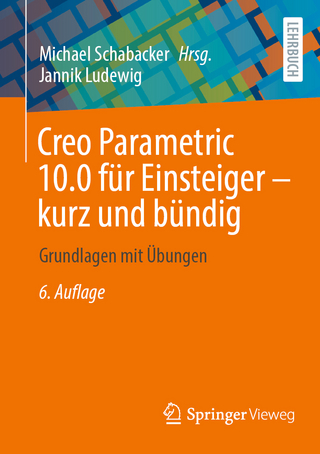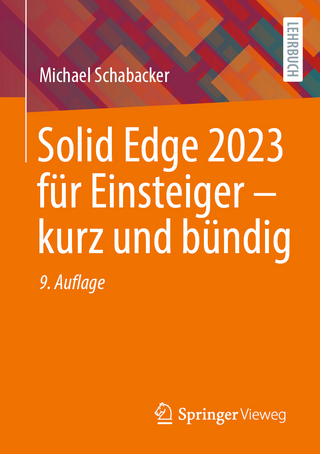
Handbook of Machining with Grinding Wheels
Crc Press Inc (Verlag)
978-1-57444-671-5 (ISBN)
- Titel erscheint in neuer Auflage
- Artikel merken
Grinding offers capabilities that range from high-rate material removal to high-precision superfinishing, and has become one of the most widely used industrial machining and surface finishing operations. Reflecting modern developments in the science and practice of modern grinding processes, the Handbook of Machining with Grinding Wheels presents a broad range of abrasive machining technologies with a focus on the fundamental concepts and practical applications.
Written by an international team of experts unrivalled in their experience and standing in the field, this comprehensive reference takes a unified approach to abrasive machining that emphasizes the underlying physical principles and how this knowledge can best be applied to solving new grinding problems. Coverage is split neatly into two main sections, with the first dedicated to basic concepts such as grinding parameters, removal mechanisms, abrasive characteristics, and economic efficiency. The remainder of the book addresses applications, including grinding of ductile and brittle materials, grinding machines, and surface, cylindrical, internal, centerless, and ultrasonic-assisted grinding.
Reflecting the diverse research and industrial experience of the authors, the Handbook of Machining with Grinding Wheels combines theoretical and practical information into an authoritative and convenient reference source. It will help deepen knowledge and sharpen problem-solving skills applied to practically any industrial grinding challenge.
THE BASIC PROCESS OF GRINDING
Introduction
From Craft to Science
Basic Uses of Grinding
Elements of the Grinding System
The Importance of the Abrasive
Grinding Wheels for a Purpose
Problem Solving
References
Grinding Parameters
Introduction
Process Parameters
Grinding Temperatures
Appendix: Drawing Form and Profile Tolerancing
References
Material Removal Mechanisms
Significance
Grinding Wheel Topography
Determination of Grinding Wheel Topography
Kinematics of the Cutting Edge Engagement
Fundamental Removal Mechanisms
Material Removal in Grinding of Ductile Materials
Surface Formation in Grinding of Brittle-Hard Materials
Energy Transformation
References
Grinding Wheels
Introduction
Wheel Shape Specification
Wheel Balance
Design of High-Speed Wheels
Bond Life
Wheel Mount Design
Wheel Design and Chatter Suppression
References
The Nature of the Abrasive
Introduction
Silicon Carbide
Alumina (Alox)-Based Abrasives
Electrofused Alumina Abrasives
Chemical Precipitation and/or Sintering of Alumina
Diamond Abrasives
CBN
Grain Size Distributions
Future Grain Developments
Postscript
References
Specification of the Bond
Introduction
Single-Layer Wheels
Electroplated (EP) Single-Layer Wheels
Brazed Single-Layer Wheels
Vitrified Bond Wheels for Conventional Wheels
Vitrified Bonds for Diamond Wheels
Vitrified Bonds for CBN
Resin Bond Wheels
Plastic Bonds
Phenolic Resin Bonds
Polyimide Resin Bonds
Metal Bonds
Other Bond Systems
References
Dressing
Introduction
Traverse Dressing of Conventional Vitrified Wheels with Stationary Tools
Traverse Dressing of Superabrasive Wheels with Stationary Tools
Uniaxial Traverse Dressing of Conventional Wheels with Rotary Diamond Tools
Uniaxial Traverse Dressing of Vitrified CBN Wheels with Rotary Diamond Tools
Cross-Axis Traverse Dressing with Diamond Discs
Diamond Form-Roll Dressing
Truing and Conditioning of Superabrasive Wheels
References
Grinding Dynamics
Introduction
Forced and Regenerative Vibrations
The Effect of Workpiece Velocity
Geometrical Interference between Grinding Wheel and Workpiece
Vibration Behavior of Various Grinding Operations
Regenerative Self-Excited Vibrations
Suppression of Grinding Vibrations
Conclusions
References
Grinding Wheel Wear
Three Types of Wheel Wear
Wheel Wear Mechanisms
Wear of the Abrasive Grains
Bond Wear
Assessment of Wheel Wear
References
Coolants
Introduction
Basic Properties of Grinding Fluids
Types of Grinding Fluids
Base Materials
Additives
Application Results
Environmental Aspects
The Supply System
Grinding Fluid Nozzles
Influence of the Grinding Fluid in Grinding
References
Monitoring of Grinding Processes
The Need for Process Monitoring
Sensors for Monitoring Process Variables
Sensor for Monitoring the Grinding Wheel
Sensors for Monitoring the Workpiece
Sensors for Peripheral Systems
References
Economics of Grinding
Introduction
A Grinding Cost Comparison Based on an Available Grinding Machine
A Cost Comparison Including Capital Investment
Cost Comparison Including Tooling
Grinding as a Replacement for Other Processes
Multitasking Machines for Hard-Turning with Grinding
Summary
References
APPLICATION OF GRINDING PROCESSES
Grinding of Ductile Materials
Introduction
Cast Irons
Steels
Heat-Resistant Superalloys
References
Grinding of Ceramics
Introduction
Background on Ceramic Materials
Diamond Wheels for Grinding Ceramics
Physics of Grinding Ceramics
ELID Grinding of Ceramics
References
Grinding Machine Technology
The Machine Base
Foundations
Guideways
Slideway Configurations
Hydrostatic Slideways
Recirculating Rolling Element Slideways
Linear Axis Drives and Motion Control
Elements of AC Servodrive Ballscrew Systems
Linear Motor Drive Systems
Spindle Motors and Grinding Wheel Drives
Drive Arrangements for Large Conventional Wheels
Drive Arrangements for Small Wheel Spindle Units
Spindles for High-Speed Grinding
Miscellaneous Wheel Spindles and Drives
Rotary Dressing Systems
Power and Stiffness Requirements for Rotary Dressers
Rotary Dressing Spindle Examples
Dressing Infeed System
References
Surface Grinding
Types of Surface Grinding Process
Basics of Reciprocating Grinding
Basics of Creep Grinding
Basics of Speed-Stroke Grinding
Successful Application of Creep Feed Grinding
Face Grinding
Fine Grinding
Appendix: Lapping Kinematics
References
External Cylindrical Grinding
The Basic Process
High-Speed Grinding
Automotive Camlobe Grinding
Punch Grinding
Crankshaft Grinding
Roll Grinding
References
Internal Grinding
Introduction
The Internal Grinding Process
Abrasive Type
Process Parameters
Machine Tool Selection
Troubleshooting
References
Centerless Grinding
The Importance of Centerless Grinding
Basic Process
Basic Relationships
Feed Processes
Centerless Wheel and Dressing Geometry
The Workrest
Speed Control
Machine Structure
High Removal Rate Grinding
Economic Evaluation of Conventional and CBN Wheels
The Mechanics of Rounding
Vibration Stability
Dynamic Stability
Avoiding Critical Frequencies
Summary and Recommendations for Rounding
Process Control
References
Ultrasonic Assisted Grinding
Introduction
Ultrasonic Technology and Process Variants
Ultrasonic-Assisted Grinding with Workpiece Excitation
Peripheral Grinding with Radial Ultrasonic Assistance
Peripheral Grinding with Axial Ultrasonic Assistance
Ultrasonic-Assisted Grinding with Excitation of the Wheel
Summary
References
Glossary
Notation and Use of SI Units
Index
| Erscheint lt. Verlag | 21.12.2006 |
|---|---|
| Zusatzinfo | 156 equations; 167 Halftones, black and white; 70 Tables, black and white; 514 Illustrations, black and white |
| Verlagsort | Bosa Roca |
| Sprache | englisch |
| Maße | 178 x 254 mm |
| Gewicht | 1315 g |
| Themenwelt | Technik ► Maschinenbau |
| Technik ► Umwelttechnik / Biotechnologie | |
| ISBN-10 | 1-57444-671-1 / 1574446711 |
| ISBN-13 | 978-1-57444-671-5 / 9781574446715 |
| Zustand | Neuware |
| Informationen gemäß Produktsicherheitsverordnung (GPSR) | |
| Haben Sie eine Frage zum Produkt? |
aus dem Bereich



